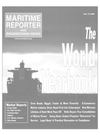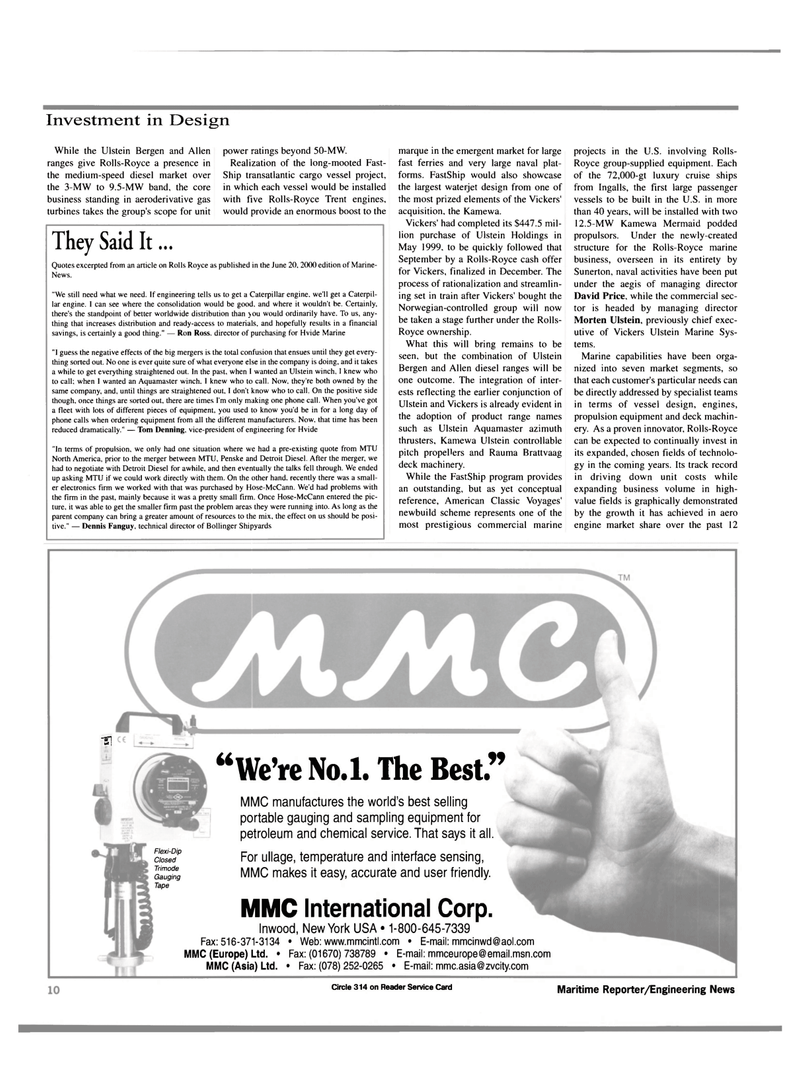
Page 10: of Maritime Reporter Magazine (June 15, 2000)
Read this page in Pdf, Flash or Html5 edition of June 15, 2000 Maritime Reporter Magazine
Investment in Design
While the Ulstein Bergen and Allen ranges give Rolls-Royce a presence in the medium-speed diesel market over the 3-MW to 9.5-MW band, the core business standing in aeroderivative gas turbines takes the group's scope for unit power ratings beyond 50-MW.
Realization of the long-mooted Fast-
Ship transatlantic cargo vessel project, in which each vessel would be installed with five Rolls-Royce Trent engines, would provide an enormous boost to the marque in the emergent market for large fast ferries and very large naval plat- forms. FastShip would also showcase the largest waterjet design from one of the most prized elements of the Vickers' acquisition, the Kamewa.
Vickers' had completed its $447.5 mil- lion purchase of Ulstein Holdings in
May 1999, to be quickly followed that
September by a Rolls-Royce cash offer for Vickers, finalized in December. The process of rationalization and streamlin- ing set in train after Vickers' bought the
Norwegian-controlled group will now be taken a stage further under the Rolls-
Royce ownership.
What this will bring remains to be seen, but the combination of Ulstein
Bergen and Allen diesel ranges will be one outcome. The integration of inter- ests reflecting the earlier conjunction of
Ulstein and Vickers is already evident in the adoption of product range names such as Ulstein Aquamaster azimuth thrusters, Kamewa Ulstein controllable pitch propellers and Rauma Brattvaag deck machinery.
While the FastShip program provides an outstanding, but as yet conceptual reference, American Classic Voyages' newbuild scheme represents one of the most prestigious commercial marine projects in the U.S. involving Rolls-
Royce group-supplied equipment. Each of the 72,000-gt luxury cruise ships from Ingalls, the first large passenger vessels to be built in the U.S. in more than 40 years, will be installed with two 12.5-MW Kamewa Mermaid podded propulsors. Under the newly-created structure for the Rolls-Royce marine business, overseen in its entirety by
Sunerton, naval activities have been put under the aegis of managing director
David Price, while the commercial sec- tor is headed by managing director
Morten Ulstein, previously chief exec- utive of Vickers Ulstein Marine Sys- tems.
Marine capabilities have been orga- nized into seven market segments, so that each customer's particular needs can be directly addressed by specialist teams in terms of vessel design, engines, propulsion equipment and deck machin- ery. As a proven innovator, Rolls-Royce can be expected to continually invest in its expanded, chosen fields of technolo- gy in the coming years. Its track record in driving down unit costs while expanding business volume in high- value fields is graphically demonstrated by the growth it has achieved in aero engine market share over the past 12
They Said It...
Quotes excerpted from an article on Rolls Royce as published in the June 20. 2000 edition of Marine-
News. "We still need what we need. If engineering tells us to get a Caterpillar engine, we'll get a Caterpil- lar engine. I can see where the consolidation would be good, and where it wouldn't be. Certainly, there's the standpoint of better worldwide distribution than >ou would ordinarily have. To us, any- thing that increases distribution and ready-access to materials, and hopefully results in a financial savings, is certainly a good thing." — Ron Ross, director of purchasing for Hvide Marine "I guess the negative effects of the big mergers is the total confusion that ensues until they get every- thing sorted out. No one is ever quite sure of what everyone else in the company is doing, and it takes a while to get everything straightened out. In the past, when I wanted an Ulstein winch. I knew who to call; when I wanted an Aquamaster winch. I knew who to call. Now, they're both owned by the same company, and, until things are straightened out, I don't know who to call. On the positive side though, once things are sorted out, there are times I'm only making one phone call. When you've got a fleet with lots of different pieces of equipment, you used to know you'd be in for a long day of phone calls when ordering equipment from all the different manufacturers. Now. that time has been reduced dramatically." — Tom Denning, vice-president of engineering for Hvide "In terms of propulsion, we only had one situation where we had a pre-existing quote from MTU
North America, prior to the merger between MTU, Penske and Detroit Diesel. After the merger, we had to negotiate with Detroit Diesel for awhile, and then eventually the talks fell through. We ended up asking MTU if we could work directly with them. On the other hand, recently there was a small- er electronics firm we worked with that was purchased by Hose-McCann. We'd had problems with the firm in the past, mainly because it was a pretty small firm. Once Hose-McCann entered the pic- ture, it was able to get the smaller firm past the problem areas they were running into. As long as the parent company can bring a greater amount of resources to the mix. the effect on us should be posi- tive." — Dennis Fanguy, technical director of Bollinger Shipyards -n x ;
Flexi-Dip
Closed
Trimode
Gauging
Tape "We're No.l. The Best."
MMC manufactures the world's best selling portable gauging and sampling equipment for petroleum and chemical service. That says it all.
For ullage, temperature and interface sensing,
MMC makes it easy, accurate and user friendly.
MMC International Corp.
Inwood, New York USA • 1-800-645-7339
Fax:516-371-3134 • Web: www.mmcintl.com • E-mail: [email protected]
MMC (Europe) Ltd. • Fax:(01670)738789 • E-mail: [email protected]
MMC (Asia) Ltd. • Fax:(078)252-0265 • E-mail: [email protected]
Circle 314 on Reader Service Card Maritime Reporter/Engineering News

 9
9

 11
11
